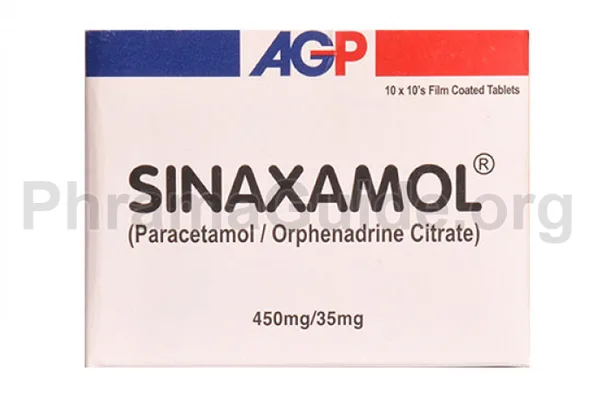Sinaxamol is a combination of Paracetamol and Orphenadrine Citrate is used to relieve pain and muscle spasms. Both medications can have side effects, and when used together, the risk of side effects can increase. Here are common and less common side effects associated with Sinaxamol.
Common Side Effects
- Drowsiness: Sinaxamol can cause drowsiness or sedation, making it important to avoid activities that require mental alertness, such as driving, while taking this medication.
- Dry Mouth: Dry mouth is a common side effect of Orphenadrine Citrate an ingredient of Sinaxamol, and it can be bothersome. Staying hydrated and sucking on sugarless candies or chewing gum may help alleviate this symptom.
- Dizziness: Dizziness is another common side effect and can be more pronounced when you stand up quickly. It’s advisable to rise slowly from a sitting or lying position to minimize this effect.
- Nausea: Some people may experience nausea when taking Sinaxamol. Taking it with food or milk can help reduce nausea.
Less Common Side Effects
- Constipation: Sinaxamol can cause constipation in some individuals. A diet rich in fiber and staying hydrated can help prevent or alleviate this side effect.
- Blurred Vision: Blurred vision is a less common side effect but may occur with Sinaxamol. Avoid activities that require clear vision, like driving, until your vision is back to normal.
- Increased Heart Rate (Tachycardia): Sinaxamol may cause an increased heart rate (tachycardia) in some individuals. If you experience a rapid or irregular heartbeat, contact your healthcare provider.
- Difficulty Urinating: In rare cases, Sinaxamol can lead to difficulty in urination or urinary retention. If you experience trouble urinating, consult your healthcare provider.
- Allergic Reaction: While allergic reaction is rare, It can include symptoms like rash, itching, swelling, severe dizziness, and difficulty breathing.
- Hallucinations: Hallucinations are an uncommon side effect but have been reported with the use of Sinaxamol. If you experience hallucinations, contact your healthcare provider.
- Confusion: Confusion or disorientation may occur with Sinaxamol use, especially in older adults or with higher doses of Sinaxamol.
- Seizures: Seizures are a rare but serious side effect associated with the use of Sinaxamol. If you experience a seizure, seek immediate medical attention.

What is Sinaxamol?
Sinaxamol is one of the leading brands of Paracetamol and Orphenadrine Citrate, manufactured and marketed by AGP Pharma Pakistan.
Sinaxamol : Available Formulations and Strengths
Presently, Sinaxamol is available in Tablet Form
Sinaxamol Tablet : Paracetamol 450mg, and Orphenadrine 35mg Strengths
What Are The Possible Drug Interactions of Sinaxamol?
- Central Nervous System Depressants: Sinaxamol can cause drowsiness and central nervous system depression. Combining them with other drugs that have a similar effect, such as other muscle relaxants, opioid pain medications, sedatives, or alcohol, can increase the risk of excessive sedation and impaired cognitive function.
- Anticholinergic Medications: Sinaxamol has anticholinergic properties, which means it can block the action of acetylcholine in the nervous system. Combining it with other anticholinergic medications, such as some antihistamines, tricyclic antidepressants, and antispasmodic drugs, may lead to an increased risk of anticholinergic side effects, including dry mouth, constipation, and blurred vision.
- Liver Enzyme Inducers: Some medications, like certain antiepileptic drugs (e.g., phenytoin and carbamazepine), can induce liver enzymes responsible for breaking down drugs in the body. This can potentially reduce the effectiveness of Sinaxamol.
- Medications That Affect Heart Rate: Sinaxamol may increase heart rate (tachycardia). Combining it with other drugs that affect heart rate, such as beta-blockers or antiarrhythmics, may lead to irregular heart rhythms.
- Anticoagulants (Blood Thinners): Sinaxamol may increase the risk of bleeding when taken with anticoagulant medications like warfarin. It’s important to monitor blood clotting parameters if you are taking both types of drugs.
- Gastrointestinal Medications: Certain medications that affect the stomach lining, such as antacids or drugs used to treat ulcers, may alter the absorption of Sinaxamol. Taking them together may reduce the effectiveness of Sinaxamol.
- MAO Inhibitors: Monoamine oxidase inhibitors (MAOIs), used to treat depression and other mental health conditions, can interact with Sinaxamol and lead to a hypertensive crisis. Combining Sinaxamol with MAOIs should be avoided.
- Urinary Alkalinizers: Drugs that increase the pH of urine may affect the elimination of Orphenadrine Citrate from the body. The combination of Sinaxamol with urinary alkalinizers should be monitored by a healthcare provider.

Leave A Comment